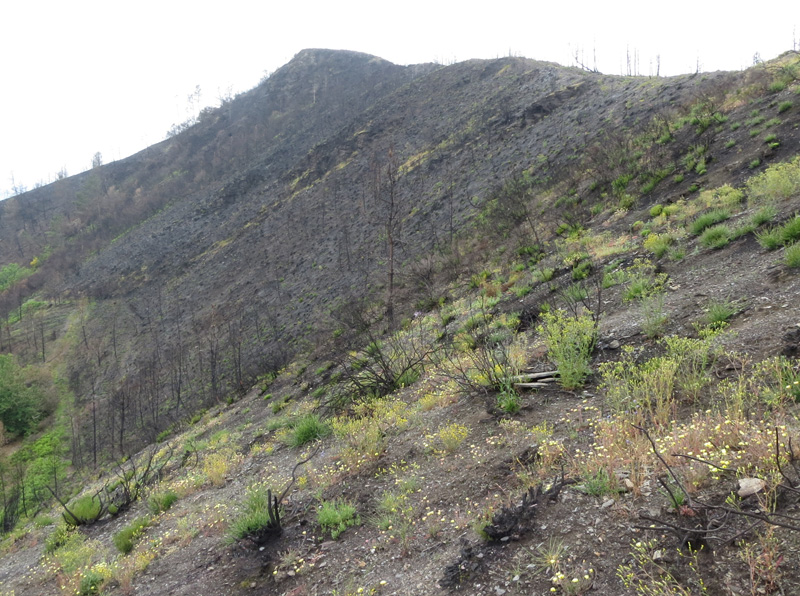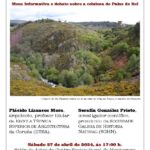The article What if the solution to forest fires was more fire? published today in Faro de Vigo highlights that a publication by University of Vigo teachers proposes “programmed and mass burning as a solution to forest fires”.
A similar “solution” was put forward three years ago (12/08/2017) by Alejandro García Hernández in the pages of El País, asserting that “prescribed burning and ‘fire-grazing’ are a sensible and efficient tool” to fight large forest fires. Then, the President of the SGHN and Scientific Researcher of CSIC (Spanish National Research Council), had sent to the opinion section of El País the article Fire-grazing? Better to graze cattle which is is available on this website from 28/08/2017.

Fire-grazing? Better to graze cattle
Some days ago, Alejandro García Hernández defended in the pages of El País that “prescribed burning and ‘fire-grazing’ are a sensible and efficient tool” to fight large forest fires. Based on my experience as researcher on the topic and inhabitant of one of most fire-active areas in Europe, I think that this statement needs, at the very least, to be very qualified. As conventional wisdom warns, if we play with fire, we are likely to get burned in the end. It is important to bear in mind that both prescribed burning and fires have effects that are rarely, if ever, taken into consideration adequately and as a whole.
On one hand, prescribed burning with a minimum of guarantees is laborious and expensive, so this is done poorly with relative frequency and it affects more surface than expected. Without going any further, three months ago Xunta de Galicia was ordered to pay damages of 160 000 euros to the owners of a timber pine forest razed by a planned burning of 2 ha of brushwood but that consumed 475 ha, many of which were groves.
But even if it is technically well executed, prescribed burning is not exempt from consequences and at CSIC we confirmed that even in small surfaces (1 ha) and prescribed burning of low severity, in which erosion was relatively scarce, rain can cause disproportionately high losses of nutrients, as it carries the most superficial layers of the ground, impoverishing it. At this point it is convenient to remember that the soil is the basis – ‘the foundation’ – of all terrestrial ecosystems and, thus, of the assets and services the soil provides to humanity. Fire and subsequent erosion reduce the capacity of the soil to act as a giant ‘sponge’ that soaks when it rains, thus reducing floods, and then releases the water slowly, reducing droughts.
Furthermore, be it in a ‘grazed’ fire or in a prescribed burning, the incomplete combustion of the organic matter of the soil and vegetation inevitably generates toxic polycyclic aromatic hydrocarbons, of which it was already documented their sedimentation in dams and coastal areas, affecting threatened species and jeopardising the wealth of fish and shellfish stocks. Ashes usually also have too high concentrations of some micronutrients and heavy metals, with risks not yet assessed for the places where they sediment.
On the other hand, official data states that 78% of the fires in Spain start for anthropogenic reasons (deliberate burning, accidents and negligence. Thus, for the most part large forest fires are NOT a “consequence of the accumulation of surplus vegetation, known as forest fuel”, but of human intervention. Therefore, if we were to think that “the so-called Triangle of Fire reminds us constantly that we can only act against the fuel” we would be very mistaken and, more importantly, we would be mistaken as to the main objective of action. In today’s humanised world, what exists is rather a “Square of Fire”, with our species dominating it from one corner, and we will achieve nothing if we do not act on the main cause of forest fires, large and small: human activity.
The brushwood is not the enemy. Occasionally it constitutes habitats of priority conservation in the European Union and is shelter to very threatened species. In other cases it is an important stage of the secondary succession which will lead to the recovery of the forest. But indeed, a continuous surface of brushwood (or dry grass, eucalyptuses, or acacias) can facilitate significantly the spread of a fire. Aside from acting over the origin of the fire (let’s remember: 78% caused by mankind), to reduce its spread we should produce discontinuities and create a mosaic of different habitats, which is also very beneficial for biodiversity. For that we have three tools: teeth, iron and fire, in other words, grazing, clearing or burning. Aside from some occasional jobs, prescribed burning and ‘fire-grazing’ do not produce goods or wealth and have the biggest environmental effects against them. In similar circumstances is mowing, but with less environmental impact. Then we have the ‘real grazing’, with livestock in extensive or semi-extensive regime that, by substituting wild large herbivores that we decimated or extinguished, controls the growth of vegetal biomass (badly named fuel) and contributes to preserve a mosaic of habitats, while generating structural jobs, helps maintain the rural population and produces food. Its recovery would also help reduce industrial livestock farming, maintained by feed largely imported and that is impacting the environment severely, even health, in numerous regions (more…).
For all that, in my opinion, the solution to the serious problem of forest fires in our country lies in resolute action as soon as possible on human originated causes, promote (semi-)extensive and well managed grazing, and resort to mechanic clearing where needed. And when we recover a more or less natural fire regime – in terms of frequency – then we could consider not extinguishing, or grazing fires of natural origin.
Article sent to the opinion section of El País by Serafín González (President of SGHN and Scientific Researcher of CSIC).
Text translated by Xoán Núñez Bazal (student of the Degree of Translation and Interpretation of the University of Vigo)






